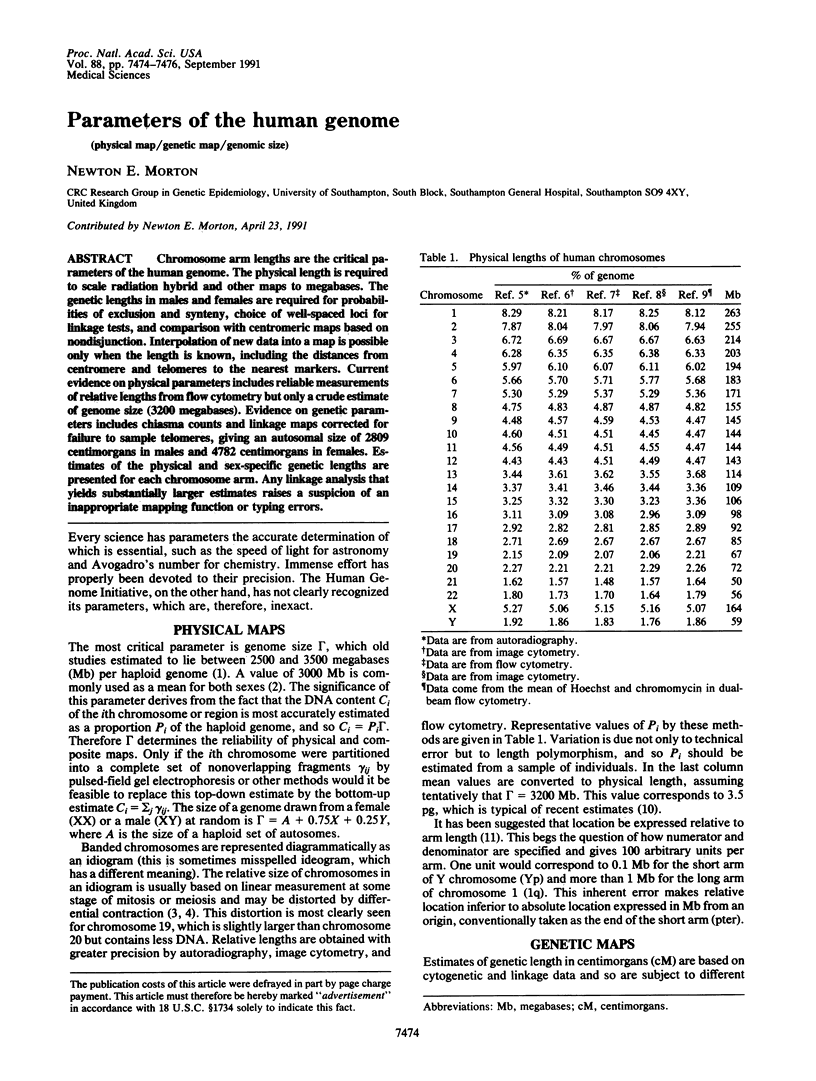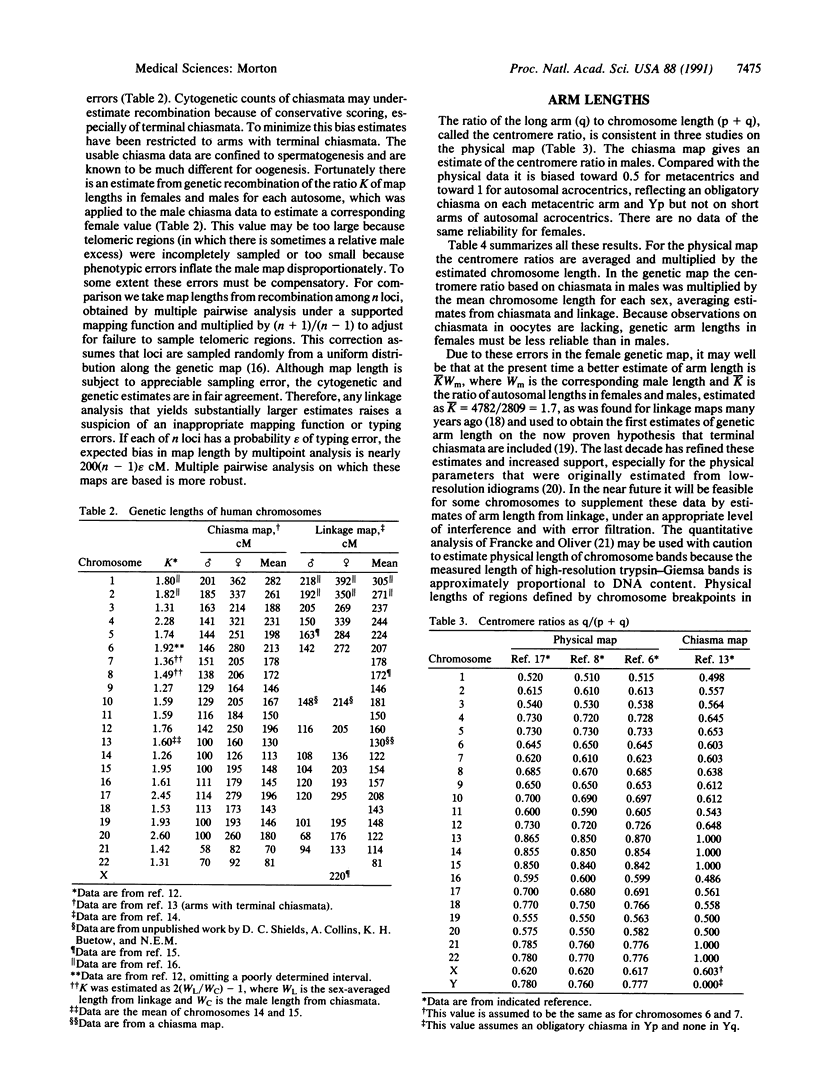Abstract
Chromosome arm lengths are the critical parameters of the human genome. The physical length is required to scale radiation hybrid and other maps to megabases. The genetic lengths in males and females are required for probabilities of exclusion and synteny, choice of well-spaced loci for linkage tests, and comparison with centromeric maps based on nondisjunction. Interpolation of new data into a map is possible only when the length is known, including the distances from centromere and telomeres to the nearest markers. Current evidence on physical parameters including the reliable measurements of relative lengths from flow cytometry but only a crude estimate of genome size (3200 megabases). Evidence on genetic parameters includes chiasma counts and linkage maps corrected for failure to sample telomeres, giving an autosomal size of 2809 centimorgans in males and 4782 centimorgans in females. Estimates of the physical and sex-specific genetic lengths are presented for each chromosome arm. Any linkage analysis that yields substantially larger estimates raises a suspicion of an inappropriate mapping function or typing errors.
Full text
PDF


Selected References
These references are in PubMed. This may not be the complete list of references from this article.
- Bodmer W. F. The William Allan Memorial Award Address: Gene clusters, Genome organization, and complex phenotypes. When the sequence is known, what will it mean? Am J Hum Genet. 1981 Sep;33(5):664–682. [PMC free article] [PubMed] [Google Scholar]
- Francke U., Oliver N. Quantitative analysis of high-resolution trypsin-giemsa bands on human prometaphase chromosomes. Hum Genet. 1978 Dec 18;45(2):137–165. doi: 10.1007/BF00286957. [DOI] [PubMed] [Google Scholar]
- Harris P., Boyd E., Young B. D., Ferguson-Smith M. A. Determination of the DNA content of human chromosomes by flow cytometry. Cytogenet Cell Genet. 1986;41(1):14–21. doi: 10.1159/000132190. [DOI] [PubMed] [Google Scholar]
- Keats B. J., Sherman S. L., Ott J. Report of the committee on linkage and gene order. Cytogenet Cell Genet. 1990;55(1-4):387–394. doi: 10.1159/000133023. [DOI] [PubMed] [Google Scholar]
- Keats B., Ott J., Conneally M. Report of the committee on linkage and gene order. Cytogenet Cell Genet. 1989;51(1-4):459–502. doi: 10.1159/000132805. [DOI] [PubMed] [Google Scholar]
- Kidd K. K., Bowcock A. M., Schmidtke J., Track R. K., Ricciuti F., Hutchings G., Bale A., Pearson P., Willard H. F., Gelernter J. Report of the DNA committee and catalogs of cloned and mapped genes and DNA polymorphisms. Cytogenet Cell Genet. 1989;51(1-4):622–947. doi: 10.1159/000132810. [DOI] [PubMed] [Google Scholar]
- Korenberg J. R., Engels W. R. Base ratio, DNA content, and quinacrine-brightness of human chromosomes. Proc Natl Acad Sci U S A. 1978 Jul;75(7):3382–3386. doi: 10.1073/pnas.75.7.3382. [DOI] [PMC free article] [PubMed] [Google Scholar]
- Langlois R. G., Yu L. C., Gray J. W., Carrano A. V. Quantitative karyotyping of human chromosomes by dual beam flow cytometry. Proc Natl Acad Sci U S A. 1982 Dec;79(24):7876–7880. doi: 10.1073/pnas.79.24.7876. [DOI] [PMC free article] [PubMed] [Google Scholar]
- Lucas J. N., Gray J. W. Centromeric index versus DNA content flow karyotypes of human chromosomes measured by means of slit-scan flow cytometry. Cytometry. 1987 May;8(3):273–279. doi: 10.1002/cyto.990080307. [DOI] [PubMed] [Google Scholar]
- Mayall B. H., Carrano A. V., Moore D. H., 2nd, Ashworth L. K., Bennett D. E., Mendelsohn M. L. The DNA-based human karyotype. Cytometry. 1984 Jul;5(4):376–385. doi: 10.1002/cyto.990050414. [DOI] [PubMed] [Google Scholar]
- Mendelsohn M. L., Mayall B. H., Bogart E., Moore D. H., 2nd, Perry B. H. DNA content and DNA-based centromeric index of the 24 human chromosomes. Science. 1973 Mar 16;179(4078):1126–1129. doi: 10.1126/science.179.4078.1126. [DOI] [PubMed] [Google Scholar]
- Morton N. E., Collins A. Standard maps of chromosome 10. Ann Hum Genet. 1990 Jul;54(Pt 3):235–251. doi: 10.1111/j.1469-1809.1990.tb00381.x. [DOI] [PubMed] [Google Scholar]
- Morton N. E., Lindsten J., Iselius L., Yee S. Data and theory for a revised chiasma map of man. Hum Genet. 1982;62(3):266–270. doi: 10.1007/BF00333534. [DOI] [PubMed] [Google Scholar]
- Morton N. E. Multipoint mapping and the emperor's clothes. Ann Hum Genet. 1988 Oct;52(Pt 4):309–318. doi: 10.1111/j.1469-1809.1988.tb01110.x. [DOI] [PubMed] [Google Scholar]
- Tiersch T. R., Chandler R. W., Wachtel S. S., Elias S. Reference standards for flow cytometry and application in comparative studies of nuclear DNA content. Cytometry. 1989 Nov;10(6):706–710. doi: 10.1002/cyto.990100606. [DOI] [PubMed] [Google Scholar]
- Van Dyke D. L., Worsham M. J., Fisher L. J., Weiss L. The centromere index and relative length of human high-resolution G-banded chromosomes. Hum Genet. 1986 Jun;73(2):130–132. doi: 10.1007/BF00291602. [DOI] [PubMed] [Google Scholar]


